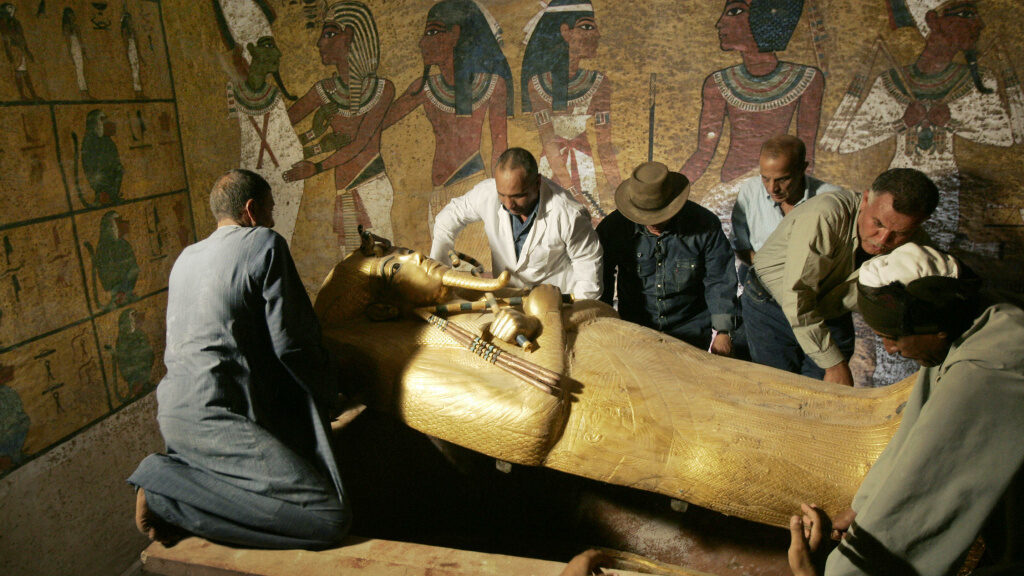‘He was NOT murdered!’ Egypt expert solves Tutankhamun mystery after new DNA test
Tutankhamun was an ancient Egyptian pharaoh who was the last of his royal family to rule at the end of the 19th Dynasty during the New Kingdom.
Known as “the boy king,” he inherited the throne at just nine years old and mysteriously died less than a decade later, with his legacy seemingly wiped from the face of the planet, leading many to claim he was murdered.
When Howard Carter discovered Tutankhamun’s tomb in the Valley of the Kings, it received worldwide interest as the pharaoh’s body was discovered alongside 5,000 artifacts in 1922.
One of the best-known Egyptologists believes that he has finally solved and the mystery of the death of Tutankhamun. He claims that the young pharaoh died after his leg became infected after an accident.
The expert claims that he has conclusive evidence that Tutankhamun was not murdered, a theory that is popular among some specialists.
He was the son of Akhenaten, the notorious heretic pharaoh, who married his own sister. As a result, Tutankhamun is believed to have been born with a number of deformities, including an elongated skull.
Tutankhamun died while he was very young. Because of damage to his mummified corpse, it has been very difficult to officially establish the cause of death, reports the Tutankhamun.com London website. There are several theories about the cause of death of the young monarch.
One theory holds that he was murdered, which was developed in the 1960s after a loose piece of bone was found in his skull. This was believed to have been the result of “a hard blow to the head” according to Tutankhamun.com London.

However, the theory that he was murdered has been challenged by Dr. Zahi Hawass, one of the most high-profile experts on ancient Egypt in the world. He long ago rejected the theory that King Tutankhamun was murdered.
The expert argues that the piece of loose bone fell from the skull of the pharaoh after death. A recent scan indicates that there are no traces or marks that would indicate that Tutankhamun received a blow to his head before he died.
The other widely accepted theory is that “a leg fracture suggests an accident may have led to his downfall” reports the Daily Star. Tests have shown that King Tut’s leg had a jagged fracture. This possibly became infected and ultimately led to his death.

The Egyptologist now believes that he will soon prove that the pharaoh died as a result of this accident and was not murdered.
Zahi Hawass and his team have developed a ‘new machine’ that will confirm the theory, states The Daily Mail. This will finally prove that the pharaoh died from a leg wound claims Hawass.
The Egyptologist states that the new techniques will allow Tut’s leg to be scanned.
Dr. Hawass also told the Daily Star, “We know that he had a fracture on his left leg and that fracture was an accident that happened to him two days before he died”. This scan will determine if he died of an infection in his leg.

In the ancient world, even relatively minor infections could prove fatal. Dr. Hawass has previously proven that Tut was suffering from malaria and as a result may have been too weak to fight off any infection.
The world-renowned Egyptologist told the Daily Star that “if he had an infection then this will confirm the idea that he died in an accident”.
This would have meant that he probably died after falling from a chariot, possibly during a hunt. However, it is likely that we may never know for certain how he fractured his leg.

Dr. Hawass believes that he and his team will finally prove how King Tutankhamun died in the coming year. He also hinted that their tests may reveal more secrets about the famous boy king.
At present many of the treasures from King Tut’s tomb are on display at an exhibition, in London at the Saatchi Gallery, which runs until the summer of 2020.
